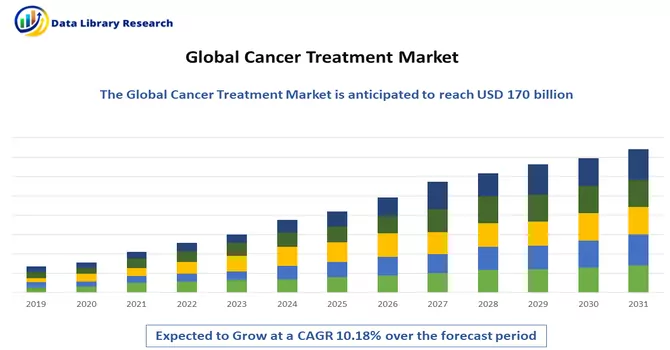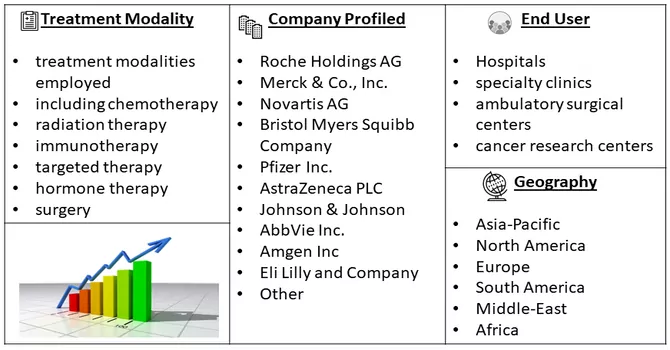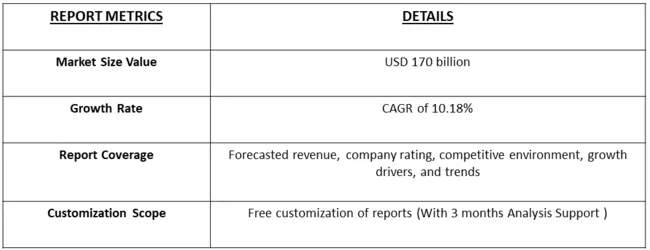The global cancer therapeutics market size is currently valued at USD 170 billion in 2023, growing at a CAGR of 10.18% during the forecast period 2024 to 2031.

Get Complete Analysis Of The Report - Download Free Sample PDF
The cancer treatment market is characterized by dynamic and transformative advancements in oncology, driven by relentless research, technological innovation, and a growing global burden of cancer cases. With a diverse range of malignancies necessitating tailored therapeutic approaches, the market encompasses various treatment modalities, including surgery, chemotherapy, radiation therapy, immunotherapy, and targeted therapies. Notably, the rise of precision medicine and the development of novel immunotherapies, such as immune checkpoint inhibitors and CAR-T cell therapies, have revolutionized cancer treatment paradigms, offering more targeted and effective options. The market's evolution is further propelled by increased collaborations between pharmaceutical companies, research institutions, and healthcare providers, fostering a multidisciplinary approach to address the complexity of cancer. As the demand for personalized and innovative treatments continues to grow, the cancer treatment market remains at the forefront of advancing medical science in the ongoing quest to combat this formidable global health challenge. A primary growth driving factor for the cancer treatment market is the unprecedented progress in precision medicine and targeted therapies. The increasing understanding of specific genetic mutations and biomarkers associated with various cancers has paved the way for the development of therapies tailored to individual patients. Precision medicine enables more effective and less toxic treatments, minimizing adverse effects and enhancing overall patient outcomes. The advent of targeted therapies, such as kinase inhibitors and immune checkpoint inhibitors, has revolutionized cancer treatment by directly addressing the molecular and immunological aspects of malignancies. This paradigm shift towards personalized and targeted approaches not only improves the efficacy of cancer treatments but also represents a significant advancement in the field, driving the continuous growth and evolution of the global cancer treatment market.
Market Segmentation: The cancer treatment market can be segmented by Treatment Modality (treatment modalities employed, including chemotherapy, radiation therapy, immunotherapy, targeted therapy, hormone therapy, and surgery.) End User: (hospitals, specialty clinics, ambulatory surgical centers, cancer research centers), and home care settings. and Geography (North America, Europe, Asia Pacific, Middle East and Africa, and South America). The market provides the value (in USD million) for the above-mentioned segments.

For Detailed Market Segmentation - Download Free Sample PDF
The cancer treatment market is marked by several prominent trends shaping its trajectory. Notably, there is a growing emphasis on immunotherapy, with immune checkpoint inhibitors and CAR-T cell therapies gaining prominence for their efficacy in treating various cancers. Precision medicine is a prevailing trend, with increased molecular profiling to identify specific genetic mutations, allowing for personalized and targeted therapies tailored to individual patients. Combination therapies, involving the simultaneous use of multiple treatment modalities or agents, are also on the rise, aiming to enhance treatment outcomes and overcome resistance mechanisms. Furthermore, the integration of artificial intelligence and machine learning in cancer diagnostics and treatment planning represents a transformative trend, streamlining decision-making processes and contributing to more efficient and effective cancer care. As research continues to advance and technology evolves, these trends collectively define the dynamic landscape of the cancer treatment market, ushering in a new era of personalized and innovative approaches to combatting malignancies.
Market Drivers:
The rapid progress in immunotherapy
The rapid progress in immunotherapy stands as a transformative force driving the cancer treatment market. Immunotherapy, characterized by breakthroughs in immune checkpoint inhibitors and CAR-T cell therapies, has revolutionized the approach to combating cancer. By leveraging the body's immune system to recognize and target cancer cells, immunotherapy has demonstrated remarkable efficacy across various malignancies, offering a paradigm shift in treatment strategies. The ability of immunotherapies to induce durable responses and potentially achieve long-term remissions has fueled their widespread adoption and integration into standard cancer care. As research continues to unveil new immunotherapeutic agents and combination approaches, the rapid progress in immunotherapy not only signifies a significant advancement in the field of oncology but also serves as a key driver propelling the continuous growth and evolution of the global cancer treatment market.
The escalating incidence of cancer cases worldwide
The escalating incidence of cancer cases worldwide represents a profound driver for the cancer treatment market. Factors such as an aging global population, lifestyle changes, and environmental influences contribute to the persistent rise in cancer prevalence. This surge in cases across various malignancies not only underscores the urgent need for effective and innovative cancer treatments but also propels extensive research and development endeavors in the oncology sector. The increasing burden of cancer places substantial pressure on healthcare systems globally, fostering a continuous demand for advanced therapeutic interventions. As the prevalence of cancer cases continues to escalate, the market responds with a heightened focus on precision medicine, targeted therapies, and immunotherapies, contributing to the ongoing evolution and expansion of the global cancer treatment market in an effort to address the multifaceted challenges posed by this complex and widespread health concern.
Market Restraints:
The cancer treatment market faces several notable restraints that impact its trajectory. One significant challenge is the high cost associated with the development, production, and administration of advanced therapeutic interventions, including immunotherapies and targeted therapies. The financial burden of these treatments may limit accessibility for certain patient populations, raising concerns about healthcare disparities. Additionally, the complexities of cancer biology, heterogeneity, and the emergence of resistance mechanisms pose challenges in developing universally effective treatments. Regulatory hurdles, stringent approval processes, and intellectual property issues can slow down the introduction of innovative therapies. The COVID-19 pandemic has further strained the market, disrupting clinical trials, delaying diagnoses, and affecting patient care. Addressing these multifaceted restraints requires collaborative efforts involving healthcare stakeholders, industry players, and policymakers to enhance affordability, streamline regulatory processes, and navigate the evolving landscape of cancer therapeutics.
The COVID-19 pandemic has significantly impacted the cancer treatment market, introducing multifaceted challenges and disruptions. The diversion of healthcare resources to address the pandemic has led to delays in cancer diagnoses, treatment initiation, and clinical trials, impacting patient care and outcomes. Patients faced heightened risks due to compromised immune systems, and healthcare facilities grappled with the need to prioritize COVID-19-related care. Supply chain disruptions and restrictions on global mobility further complicated the availability of cancer treatments and medications. The economic repercussions of the pandemic influenced healthcare budgets, affecting reimbursement policies and patient access to costly therapies. However, the crisis has also accelerated the adoption of telemedicine and digital health solutions in cancer care. While the long-term impact is yet to be fully realized, the COVID-19 pandemic has underscored the vulnerabilities of the cancer treatment market and necessitates ongoing efforts to enhance resilience, adaptability, and patient-centered care in the face of unforeseen global challenges.
Segmental Analysis:
Treatment modalities employed is Expected to Witness Significant Growth Over the Forecast Period
In the cancer treatment market, various modalities are employed to combat different types and stages of cancer. These modalities include chemotherapy, radiation therapy, immunotherapy, targeted therapy, hormone therapy, and surgery. Chemotherapy involves the use of drugs to kill cancer cells or stop their growth, often administered intravenously or orally. Radiation therapy uses high-energy radiation to shrink tumors and kill cancer cells, either externally using machines or internally via radioactive substances. Immunotherapy boosts the body's immune system to fight cancer cells, while targeted therapy uses drugs or other substances to identify and attack specific cancer cells without harming normal cells. Hormone therapy, on the other hand, involves the use of medications to interfere with hormone production or activity in order to slow or stop the growth of hormone-sensitive tumors. Finally, surgery involves physically removing tumors or cancerous tissues from the body. These diverse treatment modalities, often used in combination, contribute to the comprehensive approach to cancer treatment and management in the market.
Cancer research centers is Expected to Witness Significant Growth Over the Forecast Period
Cancer research centers play a pivotal role in advancing our understanding of cancer biology, developing innovative treatments, and improving patient outcomes. These centers are often interdisciplinary hubs where scientists, clinicians, and other experts collaborate to conduct cutting-edge research, clinical trials, and translational studies. They focus on various aspects of cancer, including its causes, prevention, diagnosis, and treatment. Cancer research centers also serve as training grounds for the next generation of cancer researchers and healthcare professionals, fostering education and mentorship programs. By driving forward scientific discoveries and fostering collaboration, cancer research centers contribute significantly to the progress made in combating cancer and ultimately improving the lives of patients worldwide.
North America Region is Expected to Witness Significant Growth Over the Forecast Period
In the North America region, cancer research centers stand as pillars of innovation and progress in the fight against cancer. With renowned institutions such as the National Cancer Institute (NCI) in the United States and the Canadian Cancer Society Research Institute (CCSRI) in Canada, North America boasts a robust network of research facilities dedicated to understanding and combating cancer. These centers leverage state-of-the-art technologies, extensive research funding, and collaboration with academic institutions, government agencies, and industry partners to drive forward groundbreaking discoveries. They conduct cutting-edge research across various disciplines, including genomics, immunotherapy, and precision medicine, with the aim of developing more effective treatments and improving patient outcomes. Additionally, these centers serve as vital resources for cancer education, advocacy, and patient support services, contributing to the overall advancement of cancer care in the region.

Get Complete Analysis Of The Report - Download Free Sample PDF
The analyzed market exhibits a high degree of fragmentation, primarily attributable to the presence of numerous players operating on both a global and regional scale. The competitive landscape is characterized by a diverse array of companies, each contributing to the overall market dynamics. This fragmentation arises from the existence of specialized solution providers, established industry players, and emerging entrants, all vying for market share. The diversity in market participants is underscored by the adoption of various strategies aimed at expanding the company presence. On a global scale, companies within the studied market are strategically positioning themselves through aggressive expansion initiatives. This often involves entering new geographical regions, targeting untapped markets, and establishing a robust global footprint. The pursuit of global expansion is driven by the recognition of diverse market opportunities and the desire to capitalize on emerging trends and demands across different regions. Simultaneously, at the regional level, companies are tailoring their approaches to align with local market dynamics. Regional players are leveraging their understanding of specific market nuances, regulatory environments, and consumer preferences to gain a competitive edge. This regional focus allows companies to cater to the unique needs of local clientele, fostering stronger market penetration. To navigate the complexities of the fragmented market, companies are implementing a range of strategies. These strategies include investments in research and development to stay at the forefront of technological advancements, mergers and acquisitions to consolidate market share, strategic partnerships for synergies, and innovation to differentiate products and services. The adoption of such multifaceted strategies reflects the competitive nature of the market, with participants continually seeking avenues for growth and sustainability. In essence, the high fragmentation in the studied market not only signifies the diversity of players but also underscores the dynamism and competitiveness that drive ongoing strategic maneuvers. As companies explore various avenues for expansion, the market continues to evolve, presenting both challenges and opportunities for industry stakeholders.
Some of the key market players are:
Recent Development:
1) In May 2023, Genmab A/S was granted approval by the USFDA for EPKINLY (epcoritamab-bysp), a T-cell engaging bispecific antibody designed for treating relapsed or refractory (R/R) diffuse large B-cell lymphoma (DLBCL) in adults.
2) In April 2023, Genentech, a member of the Roche Group, received USFDA approval for Polivy (polatuzumab vedotin-piiq), a cancer therapy drug. Polivy is approved for use in combination with Rituxan (rituximab), cyclophosphamide, doxorubicin, and prednisone (R-CHP) for treating previously untreated diffuse large B-cell lymphoma (DLBCL) in adult patients.
Q1. What was the Cancer Treatment Market size in 2023?
As per Data Library Research the global cancer therapeutics market size is currently valued at USD 170 billion in 2023.
Q2. At what CAGR is the Cancer Treatment Market projected to grow within the forecast period?
Cancer Treatment Market is growing at a CAGR of 10.18% during the forecast period.
Q3. What are the Growth Drivers of the Cancer Treatment Market?
The rapid progress in immunotherapy and The escalating incidence of cancer cases worldwide are the Growth Drivers of the Cancer Treatment Market.
Q4. Which region has the largest share of the Cancer Treatment market? What are the largest region's market size and growth rate?
North America has the largest share of the market. For detailed insights on the largest region's market size and growth rate request a sample here.
Data Library Research are conducted by industry experts who offer insight on industry structure, market segmentations technology assessment and competitive landscape (CL), and penetration, as well as on emerging trends. Their analysis is based on primary interviews (~ 80%) and secondary research (~ 20%) as well as years of professional expertise in their respective industries. Adding to this, by analysing historical trends and current market positions, our analysts predict where the market will be headed for the next five years. Furthermore, the varying trends of segment & categories geographically presented are also studied and the estimated based on the primary & secondary research.
In this particular report from the supply side Data Library Research has conducted primary surveys (interviews) with the key level executives (VP, CEO’s, Marketing Director, Business Development Manager and SOFT) of the companies that active & prominent as well as the midsized organization
FIGURE 1: DLR RESEARH PROCESS

Extensive primary research was conducted to gain a deeper insight of the market and industry performance. The analysis is based on both primary and secondary research as well as years of professional expertise in the respective industries.
In addition to analysing current and historical trends, our analysts predict where the market is headed over the next five years.
It varies by segment for these categories geographically presented in the list of market tables. Speaking about this particular report we have conducted primary surveys (interviews) with the key level executives (VP, CEO’s, Marketing Director, Business Development Manager and many more) of the major players active in the market.
Secondary ResearchSecondary research was mainly used to collect and identify information useful for the extensive, technical, market-oriented, and Friend’s study of the Global Extra Neutral Alcohol. It was also used to obtain key information about major players, market classification and segmentation according to the industry trends, geographical markets, and developments related to the market and technology perspectives. For this study, analysts have gathered information from various credible sources, such as annual reports, sec filings, journals, white papers, SOFT presentations, and company web sites.
Market Size EstimationBoth, top-down and bottom-up approaches were used to estimate and validate the size of the Global market and to estimate the size of various other dependent submarkets in the overall Extra Neutral Alcohol. The key players in the market were identified through secondary research and their market contributions in the respective geographies were determined through primary and secondary research.
Forecast Model
